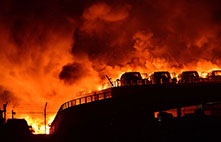Heavy smog lightens a little, but it's coming back
Updated: 2015-12-23 22:25
By Zheng Jinran in Beijing and Zhang Yu in Shijiazhuang(chinadaily.com.cn)
|
||||||||
Heavily polluted cities in China's northern region saw some improvement in air quality on Wednesday.
Beijing lifted its second red alert, but pollution is expected to persist until Sunday in eastern areas.
Beijing eased emission restrictions after four days, mainly on vehicle use and industrial production. The red alert, the highest warning for smog expired at midnight on Tuesday as planned.
Environmental authorities worked to reduce the concentration of PM2.5 — particulate matter with a diameter less than 2.5 microns that poses health risks — 20 to 25 percent below simulation levels for the alert period, said Zhang Dawei, head of Beijing Municipal Environmental Monitoring Center on Wednesday.
The peak reading of PM2.5 in Beijing was 831 micrograms per cubic meter, Zhang said.
"Air pollution in November and December was more severe than the same period in the past three years," he said.
The main contributor of pollutants is soaring coal consumption, said Meng Fan, an air pollution researcher at the China Research Academy of Environmental Sciences.
Residents in the capital didn't see the improvement in air quality until Wednesday afternoon, as cities north of Beijing remained engulfed by heavy smog, waiting for stronger wind to disperse it.
Since Dec 19, China's vast northern region, including Beijing, Tianjin and Hebei province has been hit hard. Smog covered 48 cities spread over more than 660,000 square kilometers.
The smoggy region in North China will shrink, leaving areas like Shandong and Henan provinces with lighter pollution on Saturday, but the smog will come back to cover the whole region on Sunday, forecasters said.
Li Guogang, deputy head of China National Environmental Monitoring Center described the movement of smog, saying it has expanded to cover eastern coastal cities as well.
Starting on Thursday, smog will extend to the Yangtze River Delta, and cover the majority of the area on Saturday, he said, adding that the air quality will see improvement on Sunday.
Under the current conditions, 44 cities in North China have issued orange and red alerts, which have worked well to lower peak concentrations, said Wang Zifa, a researcher at the Institute of Atmospheric Physics under the Chinese Academy of Sciences.
But the emergency response cannot work for a long term, Wang said, and to effectively reduce it, the Beijng-Tianjin-Hebei area should cut total emissions "by at least 70 percent".

 Whatever the shape or size of a tree, Merry Christmas!
Whatever the shape or size of a tree, Merry Christmas!
 The world in photos: Dec 14 - 20
The world in photos: Dec 14 - 20
 First American woman who works as captain for a Chinese airline
First American woman who works as captain for a Chinese airline
 Life of a family amid Beijing's red alert smog
Life of a family amid Beijing's red alert smog
 External coffin lid of 2,000-year-old Chinese tomb opened
External coffin lid of 2,000-year-old Chinese tomb opened
 First Miss Iraq named in decades
First Miss Iraq named in decades
 Iraq holds its first beauty contest in 40 years
Iraq holds its first beauty contest in 40 years
 Highlights at the Light of the Internet Expo
Highlights at the Light of the Internet Expo
Most Viewed
Editor's Picks

|

|

|

|

|

|
Today's Top News
Shooting rampage at US social services agency leaves 14 dead
Chinese bargain hunters are changing the retail game
Chinese president arrives in Turkey for G20 summit
Islamic State claims responsibility for Paris attacks
Obama, Netanyahu at White House seek to mend US-Israel ties
China, not Canada, is top US trade partner
Tu first Chinese to win Nobel Prize in Medicine
Huntsman says Sino-US relationship needs common goals
US Weekly

|

|








